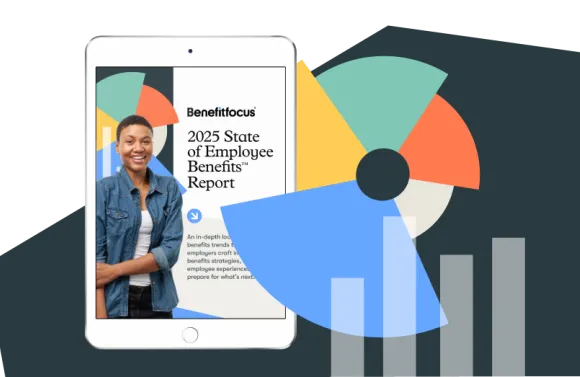
It’s been roughly 10 years since Millennials became the largest generation in the workforce, according to a 2025 Fortune article. Since then, we’ve seen premium costs and medical expenses rise, while the way many employers approach benefits communication and engagement hasn’t changed all that much.
Millennials have somewhat differing needs and expectations compared to other generations. In this article, we'll explore what employers can do to better support Millennials as they navigate their benefits and undergo significant life transitions that impact their health and financial planning.
What Employers and HR Leaders Should Know About Millennials
Millennials are those born between 1981 and 1996 and make up 36 percent of the active workforce, according to 2024 data from the U.S. Department of Labor. This makes Millennials the most common generation among all employees. Elder Millennials in their early 40s are rapidly approaching what Pew Research Center describes “the sandwich generation” phase of life, when they might need to care for aging parents while raising children at the same time. These responsibilities are often characterized by financial strain, so it’s not entirely surprising that Millennials report the highest levels of financial stress impacting their mental health and well-being (79 percent vs 71 percent across the entire workforce).1
According to the 2025 State of Employee Benefits report (SoEB), Millennials’ attitudes and preferences about benefits are unique:
- Second highest high-deductible health plan (HDHP) participation after Gen Z, when offered alongside traditional health plans.
- Underutilizes their health care—22 percent had zero medical insurance claims in 2024 (Second to Gen Z at 25 percent).
- 14 percent saw an out-of-network provider at least once.
- 74 percent receive regular preventive screenings.
- 76 percent want more information about benefit options throughout the year.
The way Millennials select and use their health benefits suggest they are interested in balancing cost vs value, similar to their younger colleagues in Gen Z.
What Makes Millennials' Benefits Needs Unique?
It’s no secret that Millennials value flexibility. According to a 2024 Forbes study, 84 percent of Millennials say flexible work is the most important benefit to their job satisfaction, followed by flexible PTO and vacation (70 percent).
Millennials also value mental health resources more than any other generation, with 68 percent reporting them as an important benefit. Similarly, 54 percent of millennial employees seek insurance coverage for mental health services, while other related requests include:
- Dedicated office spaces for processing (54 percent)
- Mental health “first responders” (49 percent)
- Mental health workshops (46 percent)
The 2024 Forbes study also revealed that Millennials report the lowest levels of job satisfaction (4.6 out of 10) across all generations, providing a ripe opportunity for employers to leverage benefits to boost overall satisfaction. According to a 2023 SHRM article, benefits are among the top three factors influencing job satisfaction, alongside respectful treatment and compensation.
As we saw when developing the SoEB, Millennials’ health insurance premiums are in the middle of the age group spread — $2,450 in 2025 — but they are rising at the fastest rate of any generation, up $300 in the last two years.2
Data from Experian in 2025 shows that many Millennials have a significant amount of debt, second only to Gen X. Their financial obligations may be similar as well — student loans, mortgages, childcare, etc — but because Millennials are earlier in their career journey than Gen X, it’s likely that a significant amount of their income is tied up in repayments. Experian data also shows that this debt is also rising at a higher rate than older generations, meaning it can become more of a burden over time.
Benefits Solutions for Millennials
With ages spanning from 29-44, Millennials may have dramatically different lives—and thus, different benefits needs. Employers can help serve everyone equitably by offering a wide range of voluntary benefits, including everything from childcare support to pet insurance. Given what we’ve seen above, mental health support and benefits are also likely desirable for Millennial employees — perhaps more so than their older colleagues, although Gen Z may feel similarly.
A major positive for employers is that Millennials are significantly more likely to read reviews before choosing a health care provider than older colleagues, according to 2022 research from National Library of Medicine. This suggests they are also more likely to take advantage of Care Navigation solutions (if provided), which can aid in selecting care types and providers and help maximize health and financial outcomes.
Higher uptake of HDHPs compared to older generations indicates Millennials are willing to adopt newer plan types in an attempt to minimize their premiums. Employers should consider offering a range of plan types that enable Millennials to keep their premiums to a minimum while the majority still enjoy good health.
Research from LIMRA’s 2024 BEAT Study suggests that, regardless of their generation, 50 percent of employees are somewhat confused by certain voluntary benefits such as critical illness* insurance, hospital indemnity insurance, long-term disability income insurance and accident insurance. Perhaps it’s understandable then that a 2024 Voya Financial Consumer Insights & Research survey3 revealed that 90 percent of working Americans typically select the same plans rather than reassessing which may be best for their needs.
Considering this, employers should recognize that benefits education, decision support and care navigation tools are essential to help younger employees understand their options and make best use of their benefits while protecting their financial health.
Engaging Millennials in Their Benefits
In general, Millennials are technologically competent and conditioned to expect seamless and user-friendly digital experiences. They are also more likely to read reviews before making decisions, as previously mentioned in 2022 research from National Library of Medicine.
This suggests that a mobile-friendly benefits hub, decision support and other care navigation tools are ideal for meeting Millennials’ needs and maximizing their health and financial wellness. Additionally, self-service is an important aspect of customer support, especially for younger generations. Gartner research from 2023 suggests that almost 40 percent of Gen Z and Millennials will give up on resolving a customer service issue if they can’t address it through self-service.
In light of this, omnichannel is a strong strategy for engaging millennials, as it ensures employees can access benefits-related information and services in the way they find most convenient. Convenience is hugely important when it comes to maximizing engagement.
Given Millennials’ propensity for seeking information and using online services, employers should consider providing a digital benefits platform that keeps pace with typical consumer services like social media and online banking and provides a familiar user experience that will help to maximize engagement.
Supporting Millennials Strengthens your Organization’s Backbone
At Benefitfocus, we help organizations make better decisions about the benefits they offer, and support employees of all ages to choose and use their benefits optimally to maximize their health and financial outcomes. In other words, we support an optimal employee experience. Some of the benefits include:
- Our industry-leading technology platform simplifies administration, drives efficiencies and enables organizations to focus on strategic initiatives for their Millennial employees, such as balancing mental health and financial responsibility.
- We make it easier for Millennial employees to make informed benefits decisions through a connected experience across health, retirement & savings.
- We support employee-first health and financial outcomes through powerful insights and a personalized experience that engages employees year-round.
- Our benefits administration solutions are intended to help organizations build a stronger workforce and control hiring costs for years to come. Health benefits and retirement planning are the top two retention benefits, according to research from iHire's Talent Retention Report 2024.
If you think your organization may be interested in these outcomes, you can find out more on our website.


